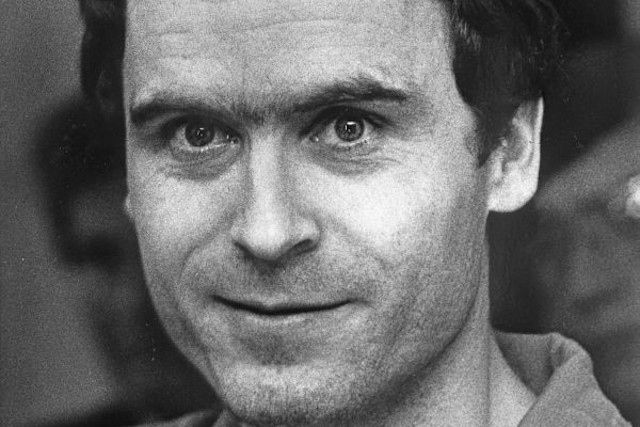Some criminals meticulously plan their actions. They will stalk a victim and commit their heinous deeds, thinking of ways to escape from the authorities and never be tied to the crime scene. There have been killers who actually shave their bodies and wear clean suits beforehand, just to leave no evidence of their involvement. But despite all the planning some killers do in advance, it is the stupid mistakes they make afterwards that often end in their downfall.
10. Ted Bundy stole a car

During Ted Bundy's reign of terror, the serial killer was responsible for at least 30 murders over a period of about 5 years. It is very likely that he committed many more crimes that we will never know about. Bundy was known as a charming man and was also considered handsome. These two traits helped him gain the trust of many of his victims. His MO was used in the film"The Silence of the Lambs" He would approach his victims during the day, in public places, pretending to be disabled and in need of help. Seeing such a charming but helpless person lulled many into a false sense of security. He would then knock them down and kidnap them before raping and murdering them.
The full details of exactly what he did are widely available, and are also surprisingly disturbing and horrific. He was a psychology student at the university and was well-liked by other students and his professors. He even went to law school in the early 1970s. It seems the only reason he didn’t finish was because he was too busy killing. When authorities turned their attention to Bundy in 1975 after he was charged with assault and kidnapping, he left Colorado for Florida and continued his crime spree.
Bundy was initially caught because he was driving with his headlights off in the early morning. When the police inspected his car, it was full of what we would consider today to be a variety of creepy items, including a ski mask, an ice pick, and handcuffs. Unfortunately, all he was charged with was kidnapping. He later escaped from prison, and was then caught again while driving a stolen car. Once again, he escaped from prison, and once again, he was caught driving a stolen car.
If he hadn't decided to steal the car the second and third time he was caught, he might have gotten away with it indefinitely.
9. Golden State Killer Left Old DNA

Lots of people are addicted to sites like Ancestry.com or 23andMe. Who wouldn't be thrilled to find out they're 11.6% Atlantean, 35.6% Scottish, and 0.4% French Canadian? But if you're a serial killer, these online DNA registries could be your undoing.
Law enforcement is using the GEDMatch website to upload a sample of the Golden State Killer's DNA left at the crime scene in the 1980s. The site is a free online database where anyone can post their genetic data, obtained from sites like 23andMe or Ancestry.com. Most people use it to help find distant relatives they didn't know about who have also uploaded their DNA results. But police used it to track down anyone who was genetically related to the Golden State Killer, a serial killer who remained at large for decades. They eventually found several cousins.
Using other information available to them, law enforcement was able to narrow down the killers based on their approximate age and location of the crime. They eventually caught and arrested Joseph James DeAngelo Jr. The former police officer committed 13 murders, 50 rapes, and more than 100 burglaries between 1973 and 1986.
The DNA that a killer left at a crime scene was previously completely useless to law enforcement. While it's a great way to identify a suspect, you need to match it to the suspect. Since the police didn't have any, the DNA was like a fingerprint without a finger to match it to. But the killer's family members had DNA tests at some point. If it weren't for the novelty of modern DNA testing, the killer might never have been caught.
8. Randy Kraft Drunk Driving

Randy Kraft was known as the Scorecard Killer, among other colorful names the media gave him for his killing spree that spanned nearly a decade from the early 1970s to the early 1980s. He killed at least 16 young men, but it is believed the actual number may be well over 50.
Kraft was nicknamed the Scorecard Killer after he was caught and it was discovered that he literally kept a scorecard of sorts that was written in code and referenced various aspects of his victims. Some of these included the initials of the victims he killed, while others detailed the various ways he mutilated their bodies.
Kraft had long been a suspect in the murders and had even been arrested before. Authorities were unable to bring charges because there was little evidence linking him to the murders. In fact, when police tried to charge him with murder, the Los Angeles District Attorney rejected investigators' request because the coroner had concluded that the specific victim in that case had died of accidental drowning, not murder. That was in 1975.
It wasn't until 1983, after Kraft had killed several more victims, that California Highway Patrol officers spotted him driving erratically on Interstate 5. After he made an illegal lane change, officers pulled him over on suspicion of drunk driving. They discovered that there was indeed a dead body in the passenger seat at the time. Police found a trove of forensic evidence, including blood from other victims, numerous Polaroids of the victims, and a scorecard detailing his crimes.
7. Alexander Bychkov robbed a store

Russian serial killer Alexander Bychkov was convicted of murdering nine people. His victims were usually elderly, sometimes homeless men, and Bychkov was known to cannibalize the victims.
Many of Bychkov's crimes were committed in the same manner. He would meet an elderly man in a bar who was either homeless or an alcoholic, and invite him to his home after a night of drinking. He would then kill them and dismember their bodies.
Bychkov made a breakthrough in 2010 when police arrested another man for the crimes and managed to get a confession from him. The man was mentally ill and the confession was believed to have been coerced.
Two years later, Bychkov stole several knives and about $300 in cash from a hardware store. After he was arrested, police searched his home and found a diary in which he detailed his life and murders. If not for the robbery, he might have held out for quite some time.
6. Arthur Shawcross returned to his body to have lunch.

Arthur Shawcross was known in the media as the Genesee River Killer. He is known to have killed at least 14 people between 1972 and 1989. He was drafted into the Army to serve in Vietnam and bragged about the horrific crimes he committed there, including beheadings and more, all of which turned out to be lies as he never saw combat.
After leaving the army, his crime spree began with burglaries and arson. He was sentenced to 22 months in prison and was actually released early after saving the life of a prison guard during a riot. The following year, he killed his first victim, a 10-year-old boy. Shortly after, he killed his second victim, an eight-year-old girl, and was arrested for the crime the following day. His lawyers allowed him to plead guilty to manslaughter for both killers. He was released after serving 14 years, deemed no longer dangerous.
In 1988, Shawcross killed again, and went on to do so, with at least 11 victims. Police were able to catch him in 1990 when he was filmed by a surveillance helicopter parked next to the body of his last victim, eating dinner and pleasuring himself. Shawcross tried to plead insanity at his trial, but no one bought it. He was sentenced to 250 years and died in prison in 2008.
5. Jeffrey Dahmer allowed his last potential victim to use the bathroom

One of the most notorious and terrifying serial killers in modern memory, Jeffrey Dahmer met his downfall because he chose to trust one of his potential victims. That misplaced trust saved the victim's life, as well as who knows how many potential victims in the future.
From the late 1970s to the early 1990s, Jeffrey Damer killed, dismembered, and in some cases ate parts of 17 victims. The full breadth of his crimes horrified the world and has since been the subject of numerous documentaries and films.
Although Dahmer had several near misses with law enforcement in the past, including one instance where a victim ran away and police actually returned the victim to his home because he convinced the cops it was just a domestic dispute, it wouldn't be until 1991 that he made a fatal mistake.
Dahmer convinced a man named Tracy Edwards to come home with him. Once they were in Dahmer's apartment, his intended victim was handcuffed and Dahmer explained that he wanted to take a picture of him and then eat his heart. Edwards assured Dahmer that he had no interest in running away from him and that they could do whatever he wanted, but he wanted to go to the bathroom and maybe have a beer. Dahmer, for some reason, thought this was a good idea, so they went back into the living room together. Edwards punched Dahmer in the face and ran out the front door.
Edwards returned to the apartment with police, who found photographic evidence of Dahmer's numerous crimes and the severed head of a refrigerator. Dahmer was sentenced to 16 life sentences, but only served a couple of years before being murdered by other inmates in 1994. If he had not agreed to let Edwards go to the bathroom and have a beer, he might never have been caught.
4. Maury Travis printed the map

Maury Travis was a suspected serial killer. He was arrested for two murders and confessed to 17 murders, although the actual number is disputed. Travis was caught after his local newspaper published an article about the disappearance and murder of one victim he had problems with.
When police investigated Travis' home, they found what was described as a torture chamber in the basement, full of bondage equipment and other tools. It also had videotapes detailing his crimes.
After the St. Louis Post-Dispatch published a story about one of his victims, Travis wrote them a letter saying he could show them where more bodies were. He included a map in an email he printed off from Expedia.com. Law enforcement was able to trace the map to Travis's computer and arrest him. He committed suicide in custody before he could stand trial.
3. Richard Kuklinski bragged

Some people can't do anything without telling other people. That's kind of the big problem with social media. It was also a problem for Richard Kuklinski, the serial killer and hitman.
Known as the Iceman, Kuklinski also had the nicknames "The Devil Himself" and "The One Man Army." He was apparently a scary guy and was convicted of five murders, although he was known to have committed many other crimes. Unfortunately for Kuklinski, he just couldn't keep his crimes to himself.
An undercover federal agent managed to trick Kuklinski into thinking he was a fellow criminal. The hitman spilled the beans on numerous crimes, detailing that he had spiked hamburgers with cyanide and committed various other murders over the years, including how he disposed of the bodies afterwards. Defense attorneys tried to argue that Kuklinski was just blowing smoke when he made these claims and that they weren't real, but the problem was that they were consistent with actual crimes.
2. Neville Heath signed the hotel register

Leaving your ID at a crime scene is probably one of the stupidest things you can do as a murderer, perhaps even stupider would be signing your name at the crime scene because it actually takes extra effort. That's what Neville Heath did.
Shortly after becoming engaged to a woman he had just met, he slept with another woman and brought her back to his hotel room. Evidence discovered the next day suggests he tortured the woman before killing her and leaving her in the room, to be found the next day using his house key. However, for some reason, he signed the hotel register with his real name when he checked in.
Oddly enough, after he wrote a letter to the police saying that, sure, it was his room but he'd let another guy use it, he left town, checked into another hotel, this time under an assumed name, and then killed another woman in exactly the same way. He was found guilty at trial and executed by hanging in 1946.
1. Henri Landru bought one-way tickets

You can look at how Henri Landru was captured as either an example of a man being too efficient or cheap. In the early 1900s, Landru was known as a womanizer. He would seduce lonely women with their savings and move on to someone else. This scam continues today, but Landru took it a step further when he began committing murder.
Most of his victims were widows. Landru would meet them as a furniture salesman. After the women lost their husbands, they would come to him and try to sell some of their property. He would tempt them with promises that he could invest the little money they had before stealing it and disappearing.
Later, he stepped up his game by claiming that he was a wealthy widower and was looking for a woman who was also widowed. He met many women this way, and using many aliases, he managed to convince these women to distance themselves from their families to be with him, and they were never seen again. This happened over and over again until some families began to investigate the disappearances of their loved ones.
Police were unable to find bodies when they began investigating Landru, but the man had a bad habit of keeping meticulous track of his finances. This included times when he bought train tickets for himself and potential brides. The problem was that he bought round-trip tickets for himself and one-way tickets for them. While no remains were found on his property, neighbors reported seeing thick black smoke coming from the chimney on more than one occasion. When police searched his massive cast-iron stove, human remains were found in the ashes.













Оставить Комментарий